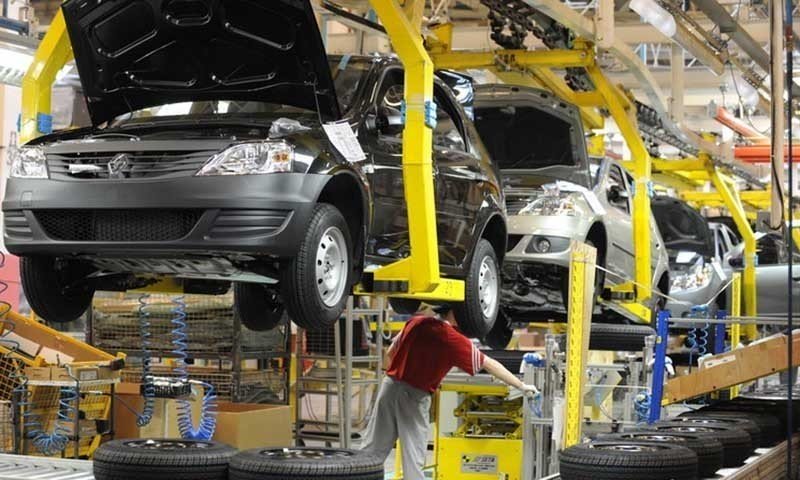Engineering Post Report
According to the facts and figures now available from the official sources concerned, with the exception of Buses, there has been a significant decline in the productivity of all sectors of the automobile industry during July-March FY2023 as compared to the same period in FY2022.
The decline in growth was primarily attributed to the import restrictions on the automobile industry, considering automobiles as luxury items, with the aim of reducing the current account deficit. In May 2022, the State Bank of Pakistan (SBP) had imposed restrictions on the auto industry, requiring prior permission for the import of raw materials and crucial parts in Completely Knocked Condition (CKDs) needed for local manufacturing of automobile parts the federal government initially allowed the auto industry to operate at about 50 percent of production capacity until foreign exchange constraints eased. However, with the deteriorating situation of Pakistani rupee exchange rate the restrictions on auto imports continued to persist, which in turn severely impacted the growth of the industry. As a result of these restrictions, the industry’s size almost halved resulting in substantial revenue loss for the federal government and significant job losses in the society on the whole.
There were additional contributing factors also. The policy rate, which was at 10 percent one year, had gradually increased to 21 percent. During this time, the value of the Pakistani rupee had also significantly declined and inflation continued to soar . As a result, auto financing became more expensive, and inflation alo drove up the prices of the automobiles, dampening demand in the market due to reduced disposable incomes. Furthermore, the auto industry also faced challenges due to the upward revision of sales tax, capital value tax, and withholding tax rates.
As briefly stated above, with the exception of buses, there had been a substantial decline in the local auto industry during July-March FY2023 as compared to the corresponding period last year. The growth in the case of buses was an anomaly, primarily due to the existing demand and available reserve stocks of parts and CKDs for buses. Next to buses, heavy commercial vehicles, particularly trucks, also experienced a decline of as much 39.8 percent as demand diminished.
The production and sales of passenger cars saw a significant decline during the period under report herewith production down by 47.3 percent to 87820 units and sales down by 50 percent to 857765 units, compared to 166768 units and 172612 units produced and sold during the corresponding period of the previous year. This decline in the production and sales was observed across all segments of passenger cars, and was primarily attributed to import restrictions that resulted in intermittent non-production days, leading to a loss in the growth for the auto industry. Despite the addition of two new products, Cherry Tiggo and Sazgar Haval, the production and sales of the light commercial vehicles (LCVs) and sports utility vehicle (SUVs) had also experienced a decline of 20 percent and 25 percent, respectively, due to the import restrictions.
The farm tractor sector also experienced a significant decline during the period with production and sales declining by 46 percent and 49 percent, respectively. Sales amounted to 21233 units compared to 41603 units sold in the corresponding period of the previous year. This sharp decline can be attributed to various factors, including constraints on the import of raw materials and critical parts, which impacted the overall productivity of the farm tractor sector. Additionally, the .industry had also been grappling with a persistent tax anomaly, where billions of rupees were locked up in refunds, hindering the natural growth of the industry.
The two/three wheelers sector was no exception and also experienced a quite significant and unprecedented decline both in production and sales, with a decrease of 33.3 percent and 33.00 percent, respectively.
Notably ,all units within the two/three wheeler sector showed negative growth during the period, as they faced supply constraints of crucial parts due to import restrictions. Two/three wheelers are known to offer a cost-effective mode of public transportation for the lower income group among the people at large, but at the same time, they are higher price-sensitive as well. The massive exchange rate losses during July-March FY2023 had resulted in rampant inflationary conditions, leading to the inevitable price increases, which in turn reduced the demand in the market for two/three wheelers.
Cars had installed capacity for 341000 against production of 166768 units during July-March 2021-22 which declined by as much as 47 percent to 87820 units during July–March 2022-23.
LCCV/Jeeps/ SUV/ Pickup had installed capacity 52000 units. Against this, the production was 32341 units during July-March 2021-22 which further declined by 19.8 percent to 25938 units during 25938 units.
Buses installed capacity was 5000 units. Against this production was o0nly 459 units in July -March 2021-22 which, however increased by 32.00 percent to 606 units during July-March 2022-23.
Trucks installed capacity was 29000 units against which production was 4445 units in July-March 2021-22 which declined by 39.8 percent to 2677 units during July—-March 2022-23.
Tractors installed capacity was 100,000 units against production was only 41872 units during July-March 2021-22 which further declined by as much as 46.00 percent to 22626 units in July-March 2022-23..
2/3 Wheelers installed capacity was the highest in the auto industry sector 2500000 units. Against this high figure, production was almost half at 1389027 units during July-March 2021-22 which further declined by 33.3 percent during July-/March 22-23 to 925943 units. On the whole, the sources pointed out , the automobile sector in the country contributes approximately 4 percent to the Gross Domestic Product (GDP) and constitutes around 15 percent of the Largest Scale Manufacturing (LSM) sector making it a quite significant contributor to the industrial out of the country on the whole and capable of meeting automobile demands domestically. It was also a major revenue generator and jobs multiplier. Over the past four decades, it may be pointed out, the country has developed a strong engineering base with investments from international brands and technology transfers.






